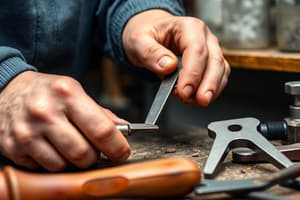Podcast
Questions and Answers
Which equipment does NOT belong to the group?
Which equipment does NOT belong to the group?
- Side cutting (correct)
- Screwdriver
- Long nose pliers
- Diagonal cutter
What is the reason why threads become stripped?
What is the reason why threads become stripped?
- Screws are over tightened (correct)
- Screws are heated
- Screws are painted
- Screws are molded
Which equipment is/are used for safety?
Which equipment is/are used for safety?
- All of those mentioned (correct)
- OHS
- VOM
- PPE
Which is NOT part of the group?
Which is NOT part of the group?
Which hand tool is used solely for cutting metals?
Which hand tool is used solely for cutting metals?
What is the primary purpose of using personal protective equipment (PPE)?
What is the primary purpose of using personal protective equipment (PPE)?
When using hand tools in the workshop, which of the following is crucial for efficiency?
When using hand tools in the workshop, which of the following is crucial for efficiency?
Which factor is least likely to affect tool longevity?
Which factor is least likely to affect tool longevity?
What describes an alternating current?
What describes an alternating current?
What is the primary function of a capacitor?
What is the primary function of a capacitor?
Which of the following best defines resistance?
Which of the following best defines resistance?
What is the purpose of an ohmmeter?
What is the purpose of an ohmmeter?
What does troubleshooting involve?
What does troubleshooting involve?
What is a key characteristic of dielectric materials?
What is a key characteristic of dielectric materials?
What role does an anode play in a semiconductor device?
What role does an anode play in a semiconductor device?
How is splicing defined in electronics?
How is splicing defined in electronics?
Which term refers to the opposition to the flow of electrons in an electrical circuit?
Which term refers to the opposition to the flow of electrons in an electrical circuit?
What is the function of an ohmmeter?
What is the function of an ohmmeter?
Which component is commonly used to offer opposition to current in an electrical circuit?
Which component is commonly used to offer opposition to current in an electrical circuit?
What does the zero-ohm adjuster in an ohmmeter do?
What does the zero-ohm adjuster in an ohmmeter do?
Which of the following best describes the role of test probes?
Which of the following best describes the role of test probes?
What does tolerance indicate in resistor color coding?
What does tolerance indicate in resistor color coding?
Which electrical quantity is measured in volts?
Which electrical quantity is measured in volts?
What does a range multiplier do in an ohmmeter?
What does a range multiplier do in an ohmmeter?
What is the primary function of the pointer in an ohmmeter?
What is the primary function of the pointer in an ohmmeter?
What aspect differentiates the ohmmeter scale from typical linear scales?
What aspect differentiates the ohmmeter scale from typical linear scales?
Which component of the ohmmeter is used to adjust when the pointer fails to point to zero?
Which component of the ohmmeter is used to adjust when the pointer fails to point to zero?
In an ohmmeter, what is the purpose of the test probes?
In an ohmmeter, what is the purpose of the test probes?
How many areas is the ohmmeter scale divided into for accurate readings?
How many areas is the ohmmeter scale divided into for accurate readings?
What is the primary use of a T-square in drafting?
What is the primary use of a T-square in drafting?
What does the range multiplier in an ohmmeter do?
What does the range multiplier in an ohmmeter do?
Why is it important to assign values to every line on the ohmmeter's nonlinear scale?
Why is it important to assign values to every line on the ohmmeter's nonlinear scale?
Which angles can set squares commonly help to draw?
Which angles can set squares commonly help to draw?
What is the purpose of a protractor in drafting?
What is the purpose of a protractor in drafting?
What commonly used instrument incorporates an ohmmeter as one of its functions?
What commonly used instrument incorporates an ohmmeter as one of its functions?
What material are set squares usually made from?
What material are set squares usually made from?
Which pencil grades are preferable for beginning a drawing?
Which pencil grades are preferable for beginning a drawing?
What does the grade '3B' denote in pencil grading?
What does the grade '3B' denote in pencil grading?
What is a compass primarily used for in drafting?
What is a compass primarily used for in drafting?
How are drawing sheets secured on the drawing board?
How are drawing sheets secured on the drawing board?
What is a characteristic of fixed resistors?
What is a characteristic of fixed resistors?
Which of the following statements about potentiometers and rheostats is true?
Which of the following statements about potentiometers and rheostats is true?
What influences the power rating of a resistor?
What influences the power rating of a resistor?
In which devices is a potentiometer typically used?
In which devices is a potentiometer typically used?
What distinguishes the rheostat from the potentiometer?
What distinguishes the rheostat from the potentiometer?
What role does the dielectric material serve in a capacitor?
What role does the dielectric material serve in a capacitor?
What happens to the electrical potential when a capacitor discharges?
What happens to the electrical potential when a capacitor discharges?
Flashcards
Alternating Current (AC)
Alternating Current (AC)
An electric current that constantly changes its direction and strength over regular intervals.
Anode
Anode
A positive electrode used in semiconductor devices.
Capacitance
Capacitance
The ability of two conductors separated by an insulating material to store electrical energy.
Capacitor
Capacitor
Signup and view all the flashcards
Circuit
Circuit
Signup and view all the flashcards
Conductor
Conductor
Signup and view all the flashcards
Current
Current
Signup and view all the flashcards
Desoldering
Desoldering
Signup and view all the flashcards
Hand Tools
Hand Tools
Signup and view all the flashcards
Screwdriver
Screwdriver
Signup and view all the flashcards
Needle-Nose Pliers
Needle-Nose Pliers
Signup and view all the flashcards
Volt-Ohm-Milliammeter (VOM)
Volt-Ohm-Milliammeter (VOM)
Signup and view all the flashcards
Power Supply
Power Supply
Signup and view all the flashcards
Personal Protective Equipment (PPE)
Personal Protective Equipment (PPE)
Signup and view all the flashcards
Safety Procedures
Safety Procedures
Signup and view all the flashcards
Proper Use of Hand Tools
Proper Use of Hand Tools
Signup and view all the flashcards
Pointer in an Ohmmeter
Pointer in an Ohmmeter
Signup and view all the flashcards
Ohmmeter Scale
Ohmmeter Scale
Signup and view all the flashcards
Range Multiplier
Range Multiplier
Signup and view all the flashcards
Zero Ohm Adjustment
Zero Ohm Adjustment
Signup and view all the flashcards
Test Probes
Test Probes
Signup and view all the flashcards
Interpreting Ohmmeter Scale
Interpreting Ohmmeter Scale
Signup and view all the flashcards
Voltage
Voltage
Signup and view all the flashcards
Ampere
Ampere
Signup and view all the flashcards
Electronic Measuring Instrument
Electronic Measuring Instrument
Signup and view all the flashcards
Resistor
Resistor
Signup and view all the flashcards
Resistor Color Coding
Resistor Color Coding
Signup and view all the flashcards
Resistance
Resistance
Signup and view all the flashcards
Tolerance
Tolerance
Signup and view all the flashcards
T-square: What is its Function?
T-square: What is its Function?
Signup and view all the flashcards
What is a Drafting Machine?
What is a Drafting Machine?
Signup and view all the flashcards
Set Squares: What are they used for?
Set Squares: What are they used for?
Signup and view all the flashcards
What Does a Protractor Do?
What Does a Protractor Do?
Signup and view all the flashcards
How do Pencil Grades Work?
How do Pencil Grades Work?
Signup and view all the flashcards
What is the Purpose of a Compass?
What is the Purpose of a Compass?
Signup and view all the flashcards
What is the function of Drawing Pins?
What is the function of Drawing Pins?
Signup and view all the flashcards
Fixed Resistor
Fixed Resistor
Signup and view all the flashcards
Carbon Resistor & Film Resistor
Carbon Resistor & Film Resistor
Signup and view all the flashcards
Variable Resistor
Variable Resistor
Signup and view all the flashcards
Potentiometer & Rheostat
Potentiometer & Rheostat
Signup and view all the flashcards
Resistor Power Rating
Resistor Power Rating
Signup and view all the flashcards
Study Notes
K to 12 Basic Education Curriculum - Technology and Livelihood Education (TLE) - Learning Module - Consumer Electronics Servicing
- This is an exploratory course leading to Consumer Electronics Servicing NC II.
- It covers five core competencies:
- Using Hand Tools
- Performing Mensuration and Calculations
- Preparing and Interpreting Technical Drawings
- Practicing Occupational Safety and Health
- Maintaining Tools and Equipment
- Each lesson focuses on achieving specific learning outcomes (LOs).
- The module includes learning activities, information sheets, self-check questions, and answer keys.
- Students should first review learning outcomes and performance standards to understand expected knowledge and skills.
- Pretests are provided to evaluate prior knowledge.
- Students should review information in the information sheet, and complete self-checks.
- Activities, Operations, and Job Sheets guide hands-on practice.
- Scoring rubrics help assess and evaluate performance.
- References include relevant books and publications.
- This module is for Grades 7 and 8.
- The learning materials cover various hand tools, like screwdrivers, soldering irons, pliers, and wire strippers. It also covers measuring instruments (like volt-ohm-milliammeters).
- It details the importance of safety procedures in the workplace, including the use of personal protective equipment (PPE).
- Different types of electronic components and their symbols are examined.
- The module emphasizes the importance of proper tool care and maintenance to avoid accidents.
- Included are procedures for soldering, desoldering, and using electronic measuring instruments.
- The module includes table of content and how to use this module, including definitions of terms, pretest, learning outcomes, and performance standards.
- This course includes activities on preparing and interpreting technical drawings, including diagrams.
Studying That Suits You
Use AI to generate personalized quizzes and flashcards to suit your learning preferences.




